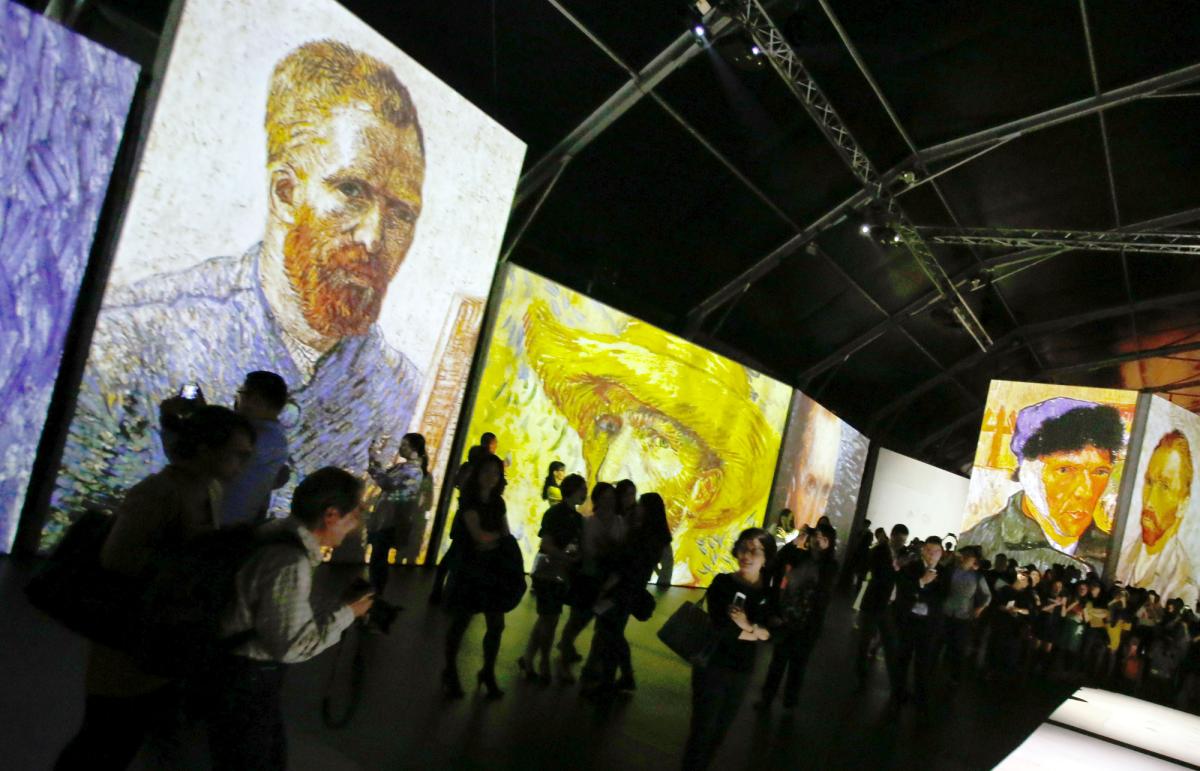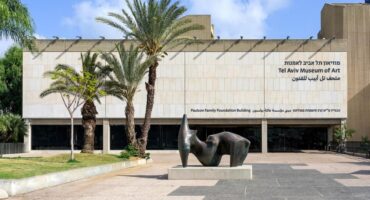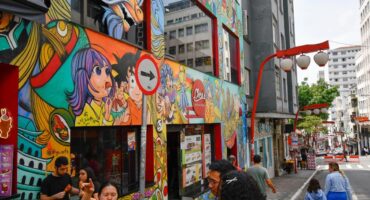In the 21st century, the artistic events have assumed a central role in contemporary global culture.
From the advent of digital technology to innovative explorations of biological materials, art has constantly reinvented itself.
In this article, let's explore the 10 most innovative artistic manifestations of this century, highlighting the creativity and diversity that characterize the current artistic scene.
Prepare to be inspired by a journey across the frontiers of human expression, where each art form challenges and redefines conventional expectations.
Through this analysis, we will delve into the depths of human creativity, exploring from urban art digital to interactive installations that invite public participation.
This is an invitation to explore art beyond the walls of traditional museums, where imagination is free to flourish and each work is a door to a world of unlimited possibilities.
1. Digital Urban Art
In digital urban art, the streets become interactive screens, where creativity intertwines with technology.
Innovative artists combine urban elements with digital tools to create works that challenge traditional art boundaries.
This dynamic fusion gives rise to new forms of visual expression, that captivate and inspire viewers around the world.
Some renowned artists in this field include:
Felipe Pantone: Known for his works that mix abstract geometry and futuristic aesthetics.
Eduardo Kobra: Recognized for his colorful and monumental wall paintings, often depicting historical and cultural figures.
Akash Nihalani: It stands out for its geometric installations and optical illusions in urban environments.
These artists, among others, create works that not only decorate urban spaces, but also provoke reflections on social issues, political and cultural.
Digital urban art transcends physical barriers, reaching a diverse audience and influencing contemporary conversations about identity, technology and urbanism.
2. Augmented Reality in Art
Augmented reality in art represents a revolution in the way we interact with visual works. This fusion of technology and artistic expression provides immersive and engaging experiences, transforming the way we perceive the world around us.
By exploring the integration of augmented reality into works of art, artists open new horizons of creative possibilities.
Using digital devices, such as smartphones and augmented reality glasses, they create works that transcend the limits of physical space, expanding into the digital realm.
Some impressive examples of augmented reality installations and projects include:
“Rain Room”: An installation that simulates constant rain controlled by motion sensors, allowing visitors to walk without getting wet.
“Wonderscope”: An augmented reality application that transforms common spaces into interactive scenarios, where children can become characters from fairy tales and animated stories.
“ARtSENSE”: A project that combines art and technology to create immersive sensory experiences, exploring themes such as the perception of reality and the nature of art.
These works not only challenge our perception of reality, but they also invite us to actively participate in artistic creation.
Augmented reality transforms the artistic experience, allowing viewers to become part of the narrative and interact with the environment in innovative and exciting ways.
3. Bioarts
Bioart emerges at the intersection between art and science, exploring the mysteries and wonders of the biological world.
This form of expression challenges traditional art conventions, incorporating biological materials and biotechnological processes in his works.
Definition and origins of bioart:
Bioart is a form of artistic expression that uses living organisms, cells, DNA and other biological materials as a means of creation.
It emerged in the 1990s 1980, with artists like Eduardo Kac, who explored the possibilities of biotechnology in their works.
Examples of works that use biological materials and biotechnological processes:
“GFP Bunny” by Eduardo Kac: A work that involved the creation of a fluorescent green transgenic rabbit.
“SymbioticA”: A bioart laboratory in Australia that produces works that challenge the boundaries between art and science.
“Tissue Culture & Art Project”: A project that grows human cells into artistic shapes, exploring questions of identity and biotechnology.
Reflection on the ethical and philosophical questions raised by bioart:
Bioart raises profound questions about ethics, genetic manipulation and the relationship between humans and other forms of life.
Many works provoke reflections on the nature of life, the fragility of existence and the role of technology in modifying the natural world.
4. Interactive Installations
Interactive installations represent an exciting and engaging form of artistic expression, that transcends the barriers between creator and viewer.
These works invite the public to actively participate, transforming from mere observers into co-authors of the artistic experience.
Analysis of artistic installations that invite public interaction:
Interactive installations are designed to encourage active viewer participation, often incorporating elements such as lights, sound, movement and technology.
Unlike static works, these installations invite the public to explore, experiment and even modify the environment around you.
Examples of notable interactive installations:
“Rain Room”: An installation that simulates constant rain controlled by motion sensors, allowing visitors to walk without getting wet.
“TeamLab Borderless”: An immersive space that combines digital art, interactive lights and projections, creating a world without borders between works of art.
“Swing Time”: An installation consisting of light swings that react to the movement of the swings, creating a unique visual and sound experience.
Discussion on the role of the viewer in creating the work of art:
In interactive installations, the viewer becomes an integral part of the work, influencing its form and meaning through their interaction.
This active role of the spectator challenges the traditional notion of art as something static and unchanging., transforming each experience into a unique collaboration between creator and audience.
5. Performance Digital
Digital performance is a form of artistic expression that constantly reinvents itself, fusing elements of the digital world with the live experience.
These performances create immersive experiences that challenge traditional notions of live art.
Exploration of performances that incorporate digital and technological elements:
Digital performances explore the potential of technological advances, integrating elements such as video projections, electronic music and digital interactivity.
These performances seek to create unique sensory experiences, transforming physical spaces into immersive and engaging environments.
Examples of remarkable digital performances:
“Eleven Play”: A Japanese dance company that combines physical movement with interactive digital projections, creating visually stunning performances.
“Björk Digital”: An immersive experience that combines music, virtual reality and audiovisual installations, allowing viewers to explore the creative world of singer Björk.
“Cirque du Soleil's Luzia”: A show that incorporates video projections mapped onto physical sets, creating a visually stunning environment for acrobats and performers.
Reflection on how digital performance challenges the boundaries of live art:
Digital performance challenges the boundaries between the virtual world and the physical world, expanding the possibilities of live art.
By integrating technology and interactivity, These performances transform the spectator into an active participant, creating experiences that transcend the limits of traditional performance.
6. Generative Art
Generative art is a form of artistic expression that relies on algorithms and automated processes to create dynamic, constantly evolving works.
This unique approach challenges traditional notions of authorship and offers new perspectives on the relationship between the artist and the work.
Explanation of the concept of generative art and its use in creating dynamic works:
Generative art is based on algorithms that generate elements of the work in a random or semi-controlled way.
These algorithms can be programmed to respond to external stimuli, such as sensory data or viewer interactions, creating works that change over time.
Examples of generative works and creative algorithms:
“Morphogenetic Creations” de Andy Lomas: A series of algorithmically generated digital sculptures that mimic biological growth processes.
“Axiom” Refik Anadol: A generative art installation that transforms real-time data into dynamic images and sounds.
“The Infinite Tree” by Michael Hansmeyer: A generative work of art that uses algorithms to generate complex branching patterns in a three-dimensional structure.
Discussion on the role of the artist in creating generative art:
In generative art, the artist acts as the creator of the algorithms and the curator of the resulting works.
Although the creation process can be automated, the artist's vision and creativity are essential in guiding the development and interpretation of the final work.
7. Graphite 3D
The 3D graffiti technique is gaining popularity due to its ability to transform urban spaces into three-dimensional art galleries.
This form of artistic expression challenges the limitations of traditional graffiti, creating optical illusions that captivate and surprise viewers.
Description of the 3D graphite technique and its growing popularity:
3D graffiti is a technique that uses shadows and perspective to create the illusion that images are bouncing off the wall.
Sign up to receive Event News
and the Universe of Arts first!
This art form has gained popularity around the world due to its stunning visual impact and its ability to transform urban spaces into dynamic works of art..
Examples of artists working with 3D graffiti:
Joe Hill: Known for his incredible 3D graffiti works that trick the eye and defy perception.
Eduardo Kobra: A renowned Brazilian artist who combines elements of traditional graffiti with 3D techniques to create vibrant and expressive murals.
Tracy Lee Stum: An artist who uses 3D graffiti to transform sidewalks into three-dimensional landscapes that appear to pop out of the ground.
Reflection on how 3D graffiti transforms urban space:
3D graffiti transforms drab urban environments into open-air art galleries, providing unique visual experiences for passersby.
This art form not only beautifies cities, but also stimulates creativity and promotes interaction between inhabitants and the urban environment.
8. Robotics Art
Robotic art represents an exciting fusion of human creativity and advanced technology, exploring the limits of artistic expression and automation.
This art form challenges traditional conventions, bringing to light complex questions about the interaction between humans and machines.
Analysis of works of art involving robotics and automation:
Robotic art incorporates elements of robotics, automation and artificial intelligence in interactive and dynamic works of art.
These works explore themes such as the relationship between humans and machines, the impact of technology on society and the nature of creativity.
Examples of robotic art artists and projects:
Nam June Paik: A pioneer of robotic art, famous for his sculptures and installations using old televisions and mechanical elements.
Leonel Moura: A Portuguese artist known for his works that explore the interaction between robots and humans, often in live performances.
Ken Rinaldo: An artist who creates interactive installations that combine robotics, biology and art, exploring questions of ecology and interconnection.
Discussion on the implications of robotic art on the relationship between humans and machines:
Robotic art raises ethical and philosophical questions about the role of machines in society and the integration of technology into everyday life.
By exploring the interaction between humans and machines, These works invite us to reflect on what it means to be human in an increasingly automated world.
9. Transmedia Art
Transmedia art is a form of artistic expression that transcends the traditional limits of media, integrating elements from different disciplines to create immersive, multifaceted experiences.
This multidisciplinary approach allows artists to explore new forms of narrative and expression, challenging established conventions.
Definition of transmedia art and its multidisciplinary approach:
Transmedia art involves the integration of different art forms, as video, music, literature and digital interactivity, in a unified experience.
This multidisciplinary approach allows artists to create works that transcend the limits of conventional media., exploring new possibilities of narrative and expression.
Examples of transmedia projects that combine different art forms:
“Ingress”: An augmented reality game that combines elements of video games, written narrative and real-time interactions.
“The Matrix”: A film franchise that extends beyond the cinema screen, including animations, comics and video games that expand the story universe.
“Sleep No More”: An immersive theater piece that combines live theater, dance, music and audience interaction in a multi-story environment.
Reflection on how transmedia art expands the limits of narrative and artistic expression:
Transmedia art challenges traditional notions of linear storytelling, allowing viewers to explore and interact with the story in non-linear ways.
This art form broadens the horizons of artistic expression, creating immersive experiences that invite audiences to actively participate in the creation of the narrative.
10. Space Art
Space art transcends terrestrial borders, exploring artistic manifestations that take place in outer space or that are inspired by spatial elements.
This form of artistic expression connects humanity with the mysteries and wonders of the universe, challenging our understanding and expanding our horizons.
Exploration of artistic manifestations that occur in outer space or that use spatial elements:
Space art covers a wide range of manifestations, from works of art created in space by astronauts to projects that use astronomical images and data.
These artistic manifestations explore themes such as the beauty of the cosmos, space exploration and the search for extraterrestrial life.
Examples of space art projects and works inspired by the cosmos:
“Overview Effect”: A series of artworks depicting astronauts' view of space, capturing the unique and transformative perspective of seeing Earth from space.
“The Hubble Cantata”: A space opera that combines music, visual projections and narration to create an immersive experience that celebrates the discoveries of the Hubble Telescope.
“Cosmic Latte”: An art installation that uses astronomical data to create a visual representation of the average color of the universe, inspired by scientific research into cosmic light.
Discussion about the role of art in exploring and understanding the universe:
Space art plays an important role in exploring and understanding the universe, by allowing viewers to emotionally connect with the mysteries of the cosmos.
This art form inspires curiosity, admiration and reflection, helping to broaden our understanding of our place in the universe and promoting a greater appreciation for the vastness and diversity of space.
Exploring the Impact of Innovation: Reflections on Artistic Manifestations of the 21st Century
In summary, This article explored the 10 most innovative artistic manifestations of the 21st century, revealing the diversity and impact of these forms of expression on contemporary art and society in general.
From the fusion of urban art with digital technology to the philosophical reflections of bioart, each manifestation offers a unique view of the world and challenges established conventions.
By revisiting these manifestations, we can appreciate how art continues to evolve and adapt to technological changes, social and cultural.
through art, we can explore new ideas, question the status quo and connect emotionally with the world around us.
Therefore, I invite all readers to continue exploring and appreciating the diversity and creativity of current artistic manifestations.
May we be inspired by the innovation and experimentation of artists and find meaning and beauty in the diverse forms of expression that the 21st century has to offer.
After all, art is a never-ending journey of discovery and learning.




